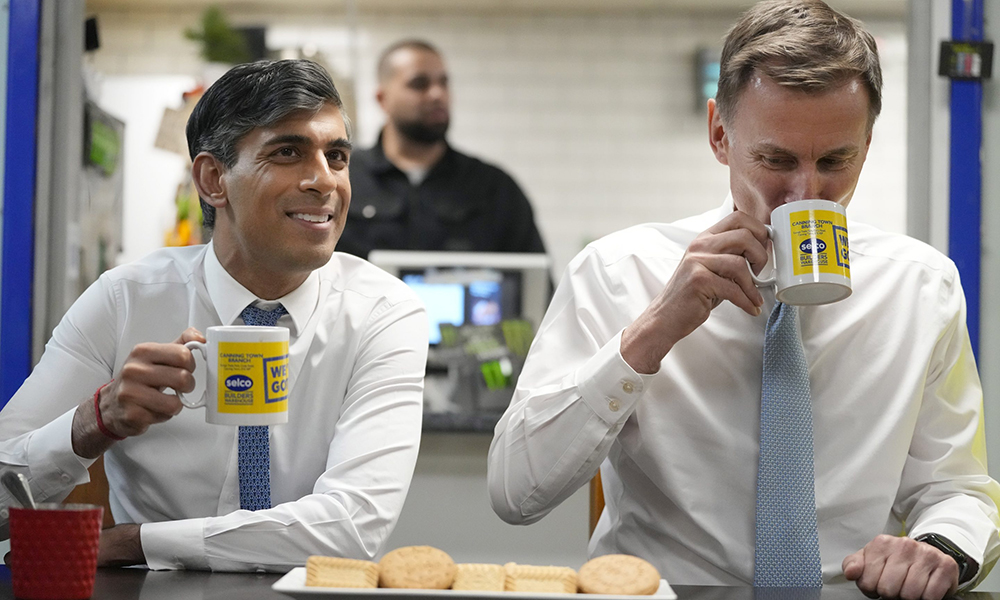
英国经济在2023年下半年陷入技术性衰退后,于今年1月出现反弹,录得温和增长。
英国国家统计局(Office for National Statistics)在3月13日公布的数据显示,英国的国内生产总值(GDP)继2023年12月下降0.1%后,今年1月增长了0.2%。服务业和建筑业实现了增长,抵消了工业产出的萎缩。
这些数据表明,英国经济整体上有望在第一季度实现增长,从而结束经济衰退。这对英国首相里希·苏纳克来说是一剂“强心剂。”民调显示,他所在的保守党预计将在今年晚些时候举行的大选中面临惨败,而苏纳克正在试图扭转这一局面。
英国国家统计局的经济学主管利兹·麦基翁说:“1月经济回暖,零售和批发业增长强劲。建筑业也表现出色,房屋建筑商在这个月也有不错的业绩。但电视和电影制作、律师和经常出现反常现象的制药业的下降部分抵消了上述增长。”
彭博经济认为……
“2023年年底冲击经济的温和衰退已经结束。今年第一季度经济增长有望回升,因此我们把2024年第一季度经济增长的预期从-0.1%上调至0.2%。最近的消息表明,英国央行(Bank of England)并不急于放松政策,经济反弹的迹象使其有理由再等待一段时间,以确认通胀率稳步回升至2%。我们将首次降息的时间从今年5月推迟到6月。”——安娜·安德拉德和丹·汉森,彭博经济(Bloomberg Economics)
然而,由于以往加息的影响继续传导至家庭和企业,经济复苏可能是温和的。分析师预计,英国将在未来一年内落后于除德国以外的七国集团(Group of Seven)的其他国家。
由于劳动力市场降温,且本周公布的数据预计将显示通胀大幅放缓,投资者押注英国央行将在今年8月开始从16年利率水平高位降息。市场目前预计,未来一年可能有四次幅度为25个基点的降息。
数据公布后,英镑兑美元汇率稳定在1.28附近。上周英镑兑美元汇率一度升至1.2894的高位,原因是有迹象表明英国的经济表现好于许多人的预期。英镑是今年十国集团中表现最好的货币,因为英国央行认为,鉴于经济增长正在反弹,英镑将在更长的时间内维持较高利率。
英国最大的雇主组织英国工业联合会(CBI)的首席经济学家本·琼斯表示:“英国经济可能正在出现转机。短期内增长势头可能依然疲弱,但今年的前景正在改善。”
由于国民保险税(以工资薪金为基数)下调了2个百分点,提高了可支配收入,强劲的零售销售推动了今年1月的经济增长。
英国财政大臣杰里米·亨特在上周的预算案里宣布,英国国民保险税再次下调2个百分点。因此,已经开始享受实际工资增长的英国家庭,有望在今年4月得到进一步提振。领取最低工资的工人的工资也将提高近10%。
亨特在报告发布后的一份声明中称:“我们在经济增长方面取得了进展,这在一定程度上使明年国民保险税减少900英镑成为可能。但如果我们想让经济增长速度加快,就必须提高工资,这意味着要终结对工资薪金进行两次征税的不公平现象。”
今年1月的经济增长受到了实习医生罢工行动的影响,导致因为工业行动而损失的天数达到了自2023年9月以来的最高水平。
零售业从令人失望的2023年12月强劲反弹,到今年1月增长3.4%,推动了当月服务业的增长。汽车维修也推动了服务业的增长。
医疗保健支出增长0.9%,主要是在私人医疗保健领域,而专业服务支出在本月增长缓慢,活动支出下降0.9%。教育支出增长0.7%。
由于私人住宅建筑商在圣诞节停工后重新开工,当月建筑业增长1.1%,超出经济学家的预期。
在工业生产中,供水和污水处理出现下降。制造业和能源供应则没有任何贡献。
在截至今年1月的三个月里,贸易赤字扩大了22亿英镑(28亿美元),达到138亿英镑,大致与去年的季度赤字持平。逆差略有扩大的原因是“服务出口大幅下降”,部分被商品逆差缩小所抵消。
英国国家统计局指出,商品出口下降,但进口降幅更大。它补充道,没有证据表明红海航运中断影响了今年的进口。
英国国家统计局表示,英国日益依赖从欧盟(EU)进口商品,今年1月英国从欧盟进口的商品比从非欧盟国家进口的商品高出58亿英镑。自2022年10月以来,从非欧盟国家的进口持续下降。当月,英国对欧盟和非欧盟国家的商品出口基本持平。
德意志银行(Deutsche Bank)的首席英国经济学家桑杰·拉贾说:“英国在2023年年底陷入的技术性衰退是暂时的。随着市场情绪回升,以及财政和货币政策在2024年之前放松,我们应该会看到经济增长在今年逐步恢复到趋势水平。”(财富中文网)
译者:中慧言-王芳
英国经济在2023年下半年陷入技术性衰退后,于今年1月出现反弹,录得温和增长。
英国国家统计局(Office for National Statistics)在3月13日公布的数据显示,英国的国内生产总值(GDP)继2023年12月下降0.1%后,今年1月增长了0.2%。服务业和建筑业实现了增长,抵消了工业产出的萎缩。
这些数据表明,英国经济整体上有望在第一季度实现增长,从而结束经济衰退。这对英国首相里希·苏纳克来说是一剂“强心剂。”民调显示,他所在的保守党预计将在今年晚些时候举行的大选中面临惨败,而苏纳克正在试图扭转这一局面。
英国国家统计局的经济学主管利兹·麦基翁说:“1月经济回暖,零售和批发业增长强劲。建筑业也表现出色,房屋建筑商在这个月也有不错的业绩。但电视和电影制作、律师和经常出现反常现象的制药业的下降部分抵消了上述增长。”
彭博经济认为……
“2023年年底冲击经济的温和衰退已经结束。今年第一季度经济增长有望回升,因此我们把2024年第一季度经济增长的预期从-0.1%上调至0.2%。最近的消息表明,英国央行(Bank of England)并不急于放松政策,经济反弹的迹象使其有理由再等待一段时间,以确认通胀率稳步回升至2%。我们将首次降息的时间从今年5月推迟到6月。”——安娜·安德拉德和丹·汉森,彭博经济(Bloomberg Economics)
然而,由于以往加息的影响继续传导至家庭和企业,经济复苏可能是温和的。分析师预计,英国将在未来一年内落后于除德国以外的七国集团(Group of Seven)的其他国家。
由于劳动力市场降温,且本周公布的数据预计将显示通胀大幅放缓,投资者押注英国央行将在今年8月开始从16年利率水平高位降息。市场目前预计,未来一年可能有四次幅度为25个基点的降息。
数据公布后,英镑兑美元汇率稳定在1.28附近。上周英镑兑美元汇率一度升至1.2894的高位,原因是有迹象表明英国的经济表现好于许多人的预期。英镑是今年十国集团中表现最好的货币,因为英国央行认为,鉴于经济增长正在反弹,英镑将在更长的时间内维持较高利率。
英国最大的雇主组织英国工业联合会(CBI)的首席经济学家本·琼斯表示:“英国经济可能正在出现转机。短期内增长势头可能依然疲弱,但今年的前景正在改善。”
由于国民保险税(以工资薪金为基数)下调了2个百分点,提高了可支配收入,强劲的零售销售推动了今年1月的经济增长。
英国财政大臣杰里米·亨特在上周的预算案里宣布,英国国民保险税再次下调2个百分点。因此,已经开始享受实际工资增长的英国家庭,有望在今年4月得到进一步提振。领取最低工资的工人的工资也将提高近10%。
亨特在报告发布后的一份声明中称:“我们在经济增长方面取得了进展,这在一定程度上使明年国民保险税减少900英镑成为可能。但如果我们想让经济增长速度加快,就必须提高工资,这意味着要终结对工资薪金进行两次征税的不公平现象。”
今年1月的经济增长受到了实习医生罢工行动的影响,导致因为工业行动而损失的天数达到了自2023年9月以来的最高水平。
零售业从令人失望的2023年12月强劲反弹,到今年1月增长3.4%,推动了当月服务业的增长。汽车维修也推动了服务业的增长。
医疗保健支出增长0.9%,主要是在私人医疗保健领域,而专业服务支出在本月增长缓慢,活动支出下降0.9%。教育支出增长0.7%。
由于私人住宅建筑商在圣诞节停工后重新开工,当月建筑业增长1.1%,超出经济学家的预期。
在工业生产中,供水和污水处理出现下降。制造业和能源供应则没有任何贡献。
在截至今年1月的三个月里,贸易赤字扩大了22亿英镑(28亿美元),达到138亿英镑,大致与去年的季度赤字持平。逆差略有扩大的原因是“服务出口大幅下降”,部分被商品逆差缩小所抵消。
英国国家统计局指出,商品出口下降,但进口降幅更大。它补充道,没有证据表明红海航运中断影响了今年的进口。
英国国家统计局表示,英国日益依赖从欧盟(EU)进口商品,今年1月英国从欧盟进口的商品比从非欧盟国家进口的商品高出58亿英镑。自2022年10月以来,从非欧盟国家的进口持续下降。当月,英国对欧盟和非欧盟国家的商品出口基本持平。
德意志银行(Deutsche Bank)的首席英国经济学家桑杰·拉贾说:“英国在2023年年底陷入的技术性衰退是暂时的。随着市场情绪回升,以及财政和货币政策在2024年之前放松,我们应该会看到经济增长在今年逐步恢复到趋势水平。”(财富中文网)
译者:中慧言-王芳
The UK economy rebounded in January, registering modest growth after falling into a technical recession in the second half of last year.
Gross domestic product rose 0.2% following a 0.1% decline in December, the Office for National Statistics said on March 13. Services and construction delivered the gains, offsetting a drop in industrial production.
The figures leave Britain on track to grow over the first quarter as a whole, bringing the recession to an end. That’s a boost for Prime Minister Rishi Sunak, who is seeking to defy opinion polls that suggest his Conservative Party is facing a heavy defeat at a general election expected later this year.
“The economy picked up in January with strong growth in retail and wholesaling,” said Liz McKeown, director of economics at the ONS. “Construction also performed well with house builders having a good month. These were partially offset by falls in TV and film production, lawyers and the often-erratic pharmaceutical industry.”
What Bloomberg Economics Says …
“The mild recession that hit the economy at the end of last year is over. Growth is on course to pick up in the first quarter of the year, and we’re revising up our call for 1Q24 to 0.2% from a fall of 0.1% as a result. Recent communication had suggested the Bank of England is in no hurry to ease policy, and signs of a rebound give it cover to wait a little longer for confirmation that inflation is on course for a durable return to 2%. We’re shifting the timing of the first rate cut back to June from May. — Ana Andrade and Dan Hanson, Bloomberg Economics.
However, the recovery is likely to be modest as past interest-rate increases continue to feed through to households and companies. Analysts expect the UK to trail every other Group of Seven country except Germany for another year.
With the labor market cooling and data this week expected to show a sharp slowdown in inflation, investors are betting the Bank of England will begin cutting rates in August from their highest level in 16 years. Markets are now pricing in four quarter-point reductions over the next year.
The pound was steady at around $1.28 after the release. It rose to as high as $1.2894 last week on signs the UK economy was holding up better than many feared. Sterling is the best performing currency across Group-of-10 peers this year, as the BOE is seen holding interest rates higher for longer given growth is rebounding.
“The economy may be turning a corner,” said Ben Jones, lead economist at the CBI, the nation’s biggest employers group. “Momentum is likely to remain weak in the near-term, but the outlook for this year is improving.”
Growth in January was boosted by strong retail sales as a 2 percentage point cut in national insurance, a payroll tax, took effect and lifted disposable incomes.
Households, which already are enjoying the return of real wage growth, can expect a further lift in April after Chancellor of the Exchequer Jeremy Hunt announced another 2-point cut in National Insurance Contributions in his budget last week. Workers on the minimum wage will also get an uplift of almost 10%.
“We are making progress in growing the economy — part of which makes it possible to bring down national insurance contributions by £900 this coming year,” Hunt said in a statement after the report. “But if we want the rate of growth to pick up more we need to make work pay, which means ending the unfairness of taxing work twice.”
Weighing on growth in January was strike action by junior doctors, which contributed to the highest number of days lost to industrial action since September.
Retail rebounded strongly from a disappointing December, growing 3.4% in January, which drove the growth in services for the month. Car repairs also drove the improvement in services.
Health spending grew 0.9%, mainly in private health care, while professional services had a slow month and saw activity drop 0.9%. Education grew by 0.7%.
Construction grew 1.1% in the month, beating economists forecasts, due to private housebuilders resuming work after Christmas shutdowns.
Within industrial production, water supply and sewerage drove a decline. Manufacturing and energy supply made no contribution.
The trade deficit widened by £2.2 billion ($2.8 billion) to £13.8 billion in the three months to January, roughly in line with the quarterly deficits across last year. The slightly larger deficit was due to a “substantial fall in services exports,” which was offset in part by a smaller deficit in goods.
Goods exports fell but imports fell by even more, the ONS said. It added that there was no evidence that disruption to shipping in the Red Sea affected imports in January.
The UK continues to be increasingly dependent on imports of goods from the EU, which were £5.8 billion higher than those from non-EU countries in the month of January, the ONS said. Imports from non-EU countries have been declining steadily since October 2022. Exports of UK goods to the EU and to no-EU countries remained roughly the same in the month.
“The technical recession that the UK slipped into late last year will be short-lived,” said Sanjay Raja, Deutsche Bank’s chief UK economist. “We should see growth gradually return to its trend rate over the course of the year as sentiment continues its uptrend and fiscal and monetary policy loosen through 2024.”






